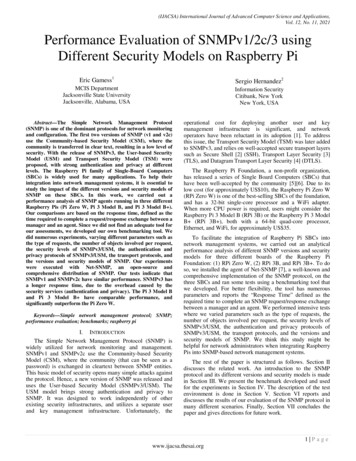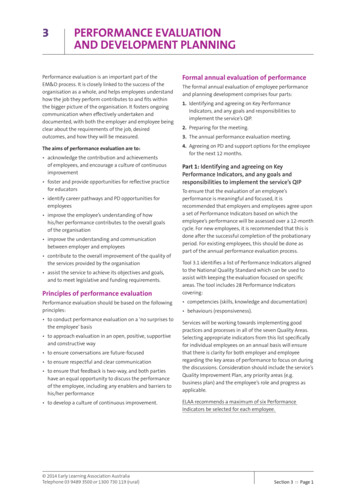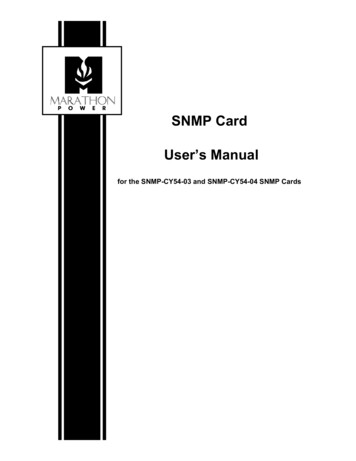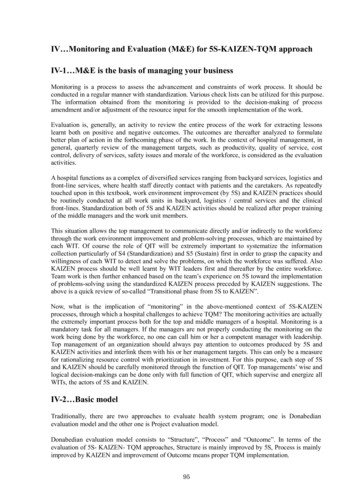
Transcription
(IJACSA) International Journal of Advanced Computer Science and Applications,Vol. 12, No. 11, 2021Performance Evaluation of SNMPv1/2c/3 usingDifferent Security Models on Raspberry PiEric Gamess1Sergio Hernandez2MCIS DepartmentJacksonville State UniversityJacksonville, Alabama, USAInformation SecurityCitibank, New YorkNew York, USAAbstract—The Simple Network Management Protocol(SNMP) is one of the dominant protocols for network monitoringand configuration. The first two versions of SNMP (v1 and v2c)use the Community-based Security Model (CSM), where thecommunity is transferred in clear text, resulting in a low level ofsecurity. With the release of SNMPv3, the User-based SecurityModel (USM) and Transport Security Model (TSM) wereproposed, with strong authentication and privacy at differentlevels. The Raspberry Pi family of Single-Board Computers(SBCs) is widely used for many applications. To help theirintegration into network management systems, it is essential tostudy the impact of the different versions and security models ofSNMP on these SBCs. In this work, we carried out aperformance analysis of SNMP agents running in three differentRaspberry Pis (Pi Zero W, Pi 3 Model B, and Pi 3 Model B ).Our comparisons are based on the response time, defined as thetime required to complete a request/response exchange between amanager and an agent. Since we did not find an adequate tool forour assessments, we developed our own benchmarking tool. Wedid numerous experiments, varying different parameters such asthe type of requests, the number of objects involved per request,the security levels of SNMPv3/USM, the authentication andprivacy protocols of SNMPv3/USM, the transport protocols, andthe versions and security models of SNMP. Our experimentswere executed with Net-SNMP, an open-source andcomprehensive distribution of SNMP. Our tests indicate thatSNMPv1 and SNMPv2c have similar performance. SNMPv3 hasa longer response time, due to the overhead caused by thesecurity services (authentication and privacy). The Pi 3 Model Band Pi 3 Model B have comparable performance, andsignificantly outperform the Pi Zero W.Keywords—Simple network management protocol; SNMP;performance evaluation; benchmarks; raspberry piI.INTRODUCTIONThe Simple Network Management Protocol (SNMP) iswidely utilized for network monitoring and management.SNMPv1 and SNMPv2c use the Community-based SecurityModel (CSM), where the community (that can be seen as apassword) is exchanged in cleartext between SNMP entities.This basic model of security opens many simple attacks againstthe protocol. Hence, a new version of SNMP was released anduses the User-based Security Model (SNMPv3/USM). TheUSM model brings strong authentication and privacy toSNMP. It was designed to work independently of otherexisting security infrastructures, and utilizes a separate userand key management infrastructure. Unfortunately, theoperational cost for deploying another user and keymanagement infrastructure is significant, and networkoperators have been reluctant in its adoption [1]. To addressthis issue, the Transport Security Model (TSM) was later addedto SNMPv3, and relies on well-accepted secure transport layerssuch as Secure Shell [2] (SSH), Transport Layer Security [3](TLS), and Datagram Transport Layer Security [4] (DTLS).The Raspberry Pi Foundation, a non-profit organization,has released a series of Single Board Computers (SBCs) thathave been well-accepted by the community [5][6]. Due to itslow cost (for approximately US 10), the Raspberry Pi Zero W(RPi Zero W) is one of the best-selling SBCs of the foundation,and has a 32-bit single-core processor and a WiFi adapter.When more CPU power is required, users might consider theRaspberry Pi 3 Model B (RPi 3B) or the Raspberry Pi 3 ModelB (RPi 3B ), both with a 64-bit quad-core processor,Ethernet, and WiFi, for approximately US 35.To facilitate the integration of Raspberry Pi SBCs intonetwork management systems, we carried out an analyticalperformance analysis of different SNMP versions and securitymodels for three different boards of the Raspberry PiFoundation: (1) RPi Zero W, (2) RPi 3B, and RPi 3B . To doso, we installed the agent of Net-SNMP [7], a well-known andcomprehensive implementation of the SNMP protocol, on thethree SBCs and ran some tests using a benchmarking tool thatwe developed. For better flexibility, the tool has numerousparameters and reports the “Response Time” defined as therequired time to complete an SNMP request/response exchangebetween a manager and an agent. We performed intensive testswhere we varied parameters such as the type of requests, thenumber of objects involved per request, the security levels ofSNMPv3/USM, the authentication and privacy protocols ofSNMPv3/USM, the transport protocols, and the versions andsecurity models of SNMP. We think this study might behelpful for network administrators when integrating RaspberryPis into SNMP-based network management systems.The rest of the paper is structured as follows. Section IIdiscusses the related work. An introduction to the SNMPprotocol and its different versions and security models is madein Section III. We present the benchmark developed and usedfor the experiments in Section IV. The description of the testenvironment is done in Section V. Section VI reports anddiscusses the results of our evaluation of the SNMP protocol inmany different scenarios. Finally, Section VII concludes thepaper and gives directions for future work.1 P agewww.ijacsa.thesai.org
(IJACSA) International Journal of Advanced Computer Science and Applications,Vol. 12, No. 11, 2021II. RELATED WORKSome work has been done to evaluate the performance ofSNMP. Andrey, Festor, Lahmadi, Pras, and Schönwälder [8]studied papers related to the evaluation of SNMP, in majorresearch databases such as the IEEE Xplore and the ACMDigital Library. Their goal was to retrieve and classifytechniques, approaches, and metrics employed by these studies,to propose a common framework for SNMP performanceanalysis. Hidalgo and Gamess [9] developed one of the firstSNMP agents for Android smartphones with support forSNMPv1 and SNMPv2c. To validate the possibility ofintegrating them into network management systems, theauthors did some performance evaluations of the maximumSNMP traffic that Android smartphones can support in adetermined period of time. In their work, Corrente and Tura[10] analyzed the impact of security on SNMP, by consideringSNMPv1, SNMPv2c, and SNMPv3/USM. They didexperiments in a testbed and reported metrics such as theprocessing time, number of transactions per minute, CPUusage, and protocol overhead. To more efficiently use SNMPin mobile environments, the study in [11] proposed to add asuperimposition model to its architecture. With simulations, theauthors supported how the proposed superimpositionarchitecture can improve the performance of SNMPv3/USM.Several studies are focused on comparing the performance ofdifferent network management solutions [12-16]. For example,the authors of [12] assessed the performance of SNMP-basedand web services-based network monitoring systems. Theiranalysis was centered around SNMPv1 and SNMPv2c, andthey reported results such as bandwidth usage, memoryconsumption, and roundtrip delay. Another work in thisdirection was done in [13], where Santos, Esteves, andGranville evaluated the performance of SNMP, NETCONF[17], and RESTful web services for router virtualizationmanagement. At the level of SNMP, the authors assessedSNMPv2c and SNMPv3/USM.The previously mentioned efforts did not consider the newTSM model of SNMPv3. In the specialized literature, just afew projects have included this emerging standard. One of thefirst evaluations was done by Du, Shayman, and Rozenblit[18], before the publication of the RFCs that introduced theTSM model [19–21]. The authors modified the source code ofNet-SNMP [7] and integrated the support of TLS [3] over TCP,for both SNMPv1 and SNMPv3. To demonstrate the viabilityof such a new development at the level of performance, theresearch team did some experiments in a testbed environment,and analyzed the performance of SNMPv1, SNMPv3/USM,and their non-standard SNMPv1 and SNMPv3 over TCP withTLS. A few years later, the work in [22] used a similarapproach for SNMP over SSH. The authors did a non-standardmodification of Net-SNMP [7] to carry SNMPv2c over SSH[2]. In a controlled environment, they assessed the performanceof SNMPv2c and SNMPv3/USM, against their non-standardmodified version of SNMPv2c over SSH. More recently,Schönwälder and Marinov [1] evaluated SNMPv3/USM andSNMPv3/TSM (with SSH, TLS, and DTLS) in a testenvironment. The testbed was made of computers connectedthrough Ethernet. They reported metrics such as the responsetime to execute snmpget and snmpwalk (retrieving theifTable table [23]) commands, and the bandwidth utilizationfor snmpwalk (retrieving the ifTable table [23]). It is worthclarifying that snmpget and snmpwalk are basic applicationsshipped with Net-SNMP [7].According to our search, the unique assessment work thatcovers SNMPv3/TSM and standard implementations of theprotocols is described in [1]. Our paper not only includesSNMPv3/TSM, but we also believe that it will be of interest inthe growing community of the Raspberry Pi [5][6].III. INTRODUCTION TO SNMP AND ITS DIFFERENTVERSIONS AND SECURITY MODELSThe Simple Network Management Protocol (SNMP) wasinitially defined in August 1988 by RFC 1067 [24] as aprotocol to monitor and control network devices, and it hasbeen used extensively for over three decades now. SNMPallows configuring network devices remotely, collectingmanagement data, and supporting the dissemination of eventnotifications [1]. Approved in 1990, SNMP became one of themain network protocols widely used as a de-facto standard bythe industry to carry out the monitoring of assets for IP-basednetworks [25]. Nevertheless, the first version of SNMP, knownas SNMPv1, is limited to meet all network managementrequirements that arise as a consequence of the interconnectioncomplexity among systems, and is exposed to several securitythreats.The architectural model of SNMP is straightforward andconsists of network management stations, agents, and manageddevices. Network management stations execute theapplications which monitor and control network elements ormanaged devices. Agents are responsible for performing thenetwork management functions requested by the networkmanagement stations, whereas managed devices may be hosts,gateways, terminal servers, switches, routers, among others.The second version of SNMP, known as SNMPv2c, is animprovement of SNMPv1 without implementing securityfeatures. Neither SNMPv1 nor SNMPv2c can provideauthentication, confidentiality, and integrity; therefore, they areexposed to multiple security threats, particularly thoseassociated with authentication and privacy [26].The third version of SNMP, known as SNMPv3, providessecurity features to the previous versions by introducing theUser-based Security Model (USM), which is used toauthenticate entities and provides encryption to secure thecommunication channel [10]. The authentication is performedusing Hashed Message Authentication Code (HMAC) based ontechniques such as Message Digest 5 (MD5) as well as SecureHash Algorithm (SHA), while encryption for privacy isperformed using Data Encryption Standard (DES) andAdvanced Encryption Standard (AES), which are symmetricalgorithms [27]. Also, SNMPv3 introduced a substantialcomplexity to SNMP architecture, since it implements its ownuser and key management infrastructure.A. SNMPv1 and SNMPv2cBoth versions, SNMPv1 and SNMPv2c, rely on theCommunity-based Security Model (CSM) by which thecommunity’s name acts as a password and is transmitted over2 P agewww.ijacsa.thesai.org
(IJACSA) International Journal of Advanced Computer Science and Applications,Vol. 12, No. 11, 2021the network in cleartext with the message. If the community’sname is recognized, then the message should be processed. Theuse of the community’s name without any encryption to verifythat the message was sent by a trusted source is inherentlyinsecure since it allows unauthorized individuals to capture itby using a packet analyzer or sniffer, and execute privilegedactions. Hence, the security of the SNMP messages isdependent on the security of the channels over which themessages are sent.C. SNMPv3/TSMThe Transport Security Model (TSM) was designed to fitinto the SNMP architecture as a Security Model that utilizesthe services of a secure Transport Model. The TSM model doesnot provide security mechanisms such as authentication andencryption itself [19]. Instead, it was implemented to workwith a variety of secure transport protocols, including SecureShell [2] (SSH), Transport Layer Security [3] (TLS), andDatagram Transport Layer Security [4] (DTLS).SNMPv1 introduced five main Protocol Data Units: (1)GetRequest, (2) GetNextRequest, (3) SetRequest, (4)GetResponse, and (5) Trap. GetRequest is used by themanager to collect the value of one or more objects managedby the agent. The manager uses GetNextRequest message torequest a series of consecutive variables managed by the agent.SetRequest is used by the manager to modify the value ofone or more objects in a managed device. GetResponse issent by agents to respond with data to get (GetRequest andGetNextRequest) and set (SetRequest) requests. Trap isused by the agent to notify that an event has occurred or that acondition is present. SNMPv1 does not allow manager-tomanager interactions [28].1) SNMPv3/SSH: The Secure Shell (SSH) protocol [2] isused for secure remote login and other secure networkservices over an insecure network. It comprises of threecomponents:Three new PDUs were added in SNMPv2c: (1)GetBulkRequest, (2) InformRequest, and (3) Report.The purpose of GetBulkRequest is the optimization ofGetNextRequest, allowing to request the transfer of a largeamount of data and reducing the number of requests andresponses. InformRequest is used by a manager to sendmanagement information to other remote managers. Usage andprecise semantics of Report are not specified; therefore, anySNMP administrative framework making use of this PDU mustdefine it. SNMPv2c improved error-handling by includingexpanded error codes to differentiate types of error conditionsreported through a single error code in SNMPv1 [29]. User Authentication Protocol: it authenticates the clientside user to the server and runs over the transport layerprotocol. SSH can support multiple user authenticationmechanisms including, but not limited to, dkeyboard-interactive authentication (which ).Through the Generic Security Service ApplicationProgram Interface (GSS-API), SSH can also interactwith the Kerberos protocol to authenticate users.B. SNMPv3/USMThe User-based Security Model (USM) providesauthentication and privacy capabilities at the SNMP messagelevel. It defines three security levels that can be summarized asfollows: Communication without authentication and privacy(noAuthNoPriv): From a security point of view, it iscomparable to the CSM used by previous versions ofSNMP. Neither authentication, nor encryption forprivacy capabilities, are provided. Communication with authentication but without privacy(authNoPriv): It provides authentication. However,encryption for privacy is not provided by this level. Communication with authentication and privacy(authPriv): It provides both authentication andencryption for privacy capabilities.The USM model implements its own user and keymanagement infrastructure, making it unpractical to beimplemented [1]. It relies on the existence of pre-shared keysbetween two communicating SNMP engines. Transport Layer Protocol: it provides server authentication, confidentiality, integrity, and compression. Itoperates over a TCP connection, however, other reliabledata streams can be used. Public-key cryptography isused to authenticate the server to the client and toestablish a secure connection, which then uses a sessionkey and a symmetric encryption algorithm to protect theconnection. Connection Protocol: it multiplexes the encryptedtunnel into several logical channels. It runs over thetransport layer protocol and starts once the userauthentication protocol has finished.2) SNMPv3/TLS: The Transport Layer Security (TLS)protocol [3] provides authentication, integrity, and privacy atthe transport layer. The TLS Transport Model (TLSTM) forSNMP consists of a model instantiation in the transportsubsystem and details the elements of procedure for sendingand receiving SNMP messages over TLS. TLSTM makes useof the X.509 public key infrastructure to provideauthentication.3) SNMPv3/DTLS: The Datagram Transport LayerSecurity (DTLS) protocol [4] is based on the TLS protocoland provides similar security capabilities. The main differencein comparison with TLS is that DTLS provides securecommunication over unreliable datagram transports (e.g.,UDP).IV. METRICS AND BENCHMARKSLet us define the “response time” as the time required foran SNMP manager to send a request and receive the associatedresponse from the agent. We could not find a software tool onthe Internet that fulfilled our need in computing the response3 P agewww.ijacsa.thesai.org
(IJACSA) International Journal of Advanced Computer Science and Applications,Vol. 12, No. 11, 2021time with precision. Hence, we wrote our own benchmarkingtool in the C programming language, using the Net-SNMPlibrary [7]. Basically, a request/response exchange is doneseveral times between our benchmarking tool and the agent.The benchmarking tool takes a timestamp before and after theinterchange. The difference in timestamps is divided by thenumber of exchanges to get the average response time.Repeating the request/response exchange several timesminimizes the error on the response time, due to low-precisionclocks and any other processes that could be started by theoperating systems and load the devices during the benchmarkexecution.The benchmark has several parameters, including theversion of SNMP, the community (only for SNMPv1 andSNMPv2c), the security name, security level (noAuthNoPriv,authNoPriv, and authPriv), the authentication protocol andpassphrase, the privacy protocol and passphrase (only forSNMPv3/USM), the digital certificates for the benchmarkingtool and the agent (only for SNMPv3/DTLS andSNMPv3/TLS), the number of sessions (numSessions), thenumber of requests/responses per session (sessionSize), thetransport protocol (UDP, TCP, DTLS, and TLS), the IP addressof the agent, and a list of parameters related to ObjectIdentifiers (OIDs). The latter list will depend on the petitions.For example, for GetRequest and GetNextRequestpetitions, it should be the list of OIDs to be resolved intovalues. For SetRequest petitions, it should be a list of triplets(OID to be altered, its type, and its new value). Fig. 1 gives theskeleton of the benchmark for computing the response time fora GetRequest petition. The line numbers have been addedjust for reference. Line 01 gets the starting timestamp. Theexternal for-loop controls the number of sessions(numSessions). For each session, the internal for-loopcontrols the number of requests/responses per session(sessionSize). Each session consists of opening the sessionwith the agent (Line 05), repeating the creation of the request(Line 07), exchanging the request and response with the agent(Line 09), and destroying the response once processed (Line11), before closing the session (Line 13). Finally, Line 16 getsthe ending timestamp, and the results are 4:15:16:17:gettimeofday(&timerStart, (struct timezone *) 0);// Get the starting timestampfor(int i 0; i numSessions; i ) {ss snmp open(&session); // Open an SNMP sessionfor(int j 0; j sessionSize; j ) {pdu snmp pdu create(SNMP MSG GET); // Create request// Add pairs of (OIDs, null) to the requeststatus snmp synch response(ss, pdu, &response);// Process the responsesnmp free pdu(response);}snmp close(ss); Close the SNMP session}gettimeofday(&timerEnd, (struct timezone *) 0);// Get the ending timestamp before showing the resultsFig. 1. Skeleton of the Code of the Benchmark to Compute the ResponseTime for a GetRequest.V. DESCRIPTION OF THE TEST ENVIRONMENTThe testbed of Fig. 2 was used for the experiments. Itconsisted of a laptop, a wireless router, and SBCs from theRaspberry Pi Foundation. The laptop and SBCs were placed 4meters from the wireless router, with no obstacles betweenthem. Section V.A gives more details about the differentmodels of SBCs (RPi Zero W, RPi 3B, and RPi 3B ) that wereused. The laptop had the following specifications: MicrosoftSurface Book with an Intel Core i7-6600U CPU at 2.81 GHz,16 GB of RAM, a 512 GB SSD, an NVIDIA GeForce GPU,and a Marvell AVASTAR Wireless-AC Network Adapter(dual-band wireless adapter with support to IEEE 802.11a/b/n/g/ac). Debian amd64 10.11.0 was installed as theoperating system. For the wireless network interconnection, aNETGEAR AC1200 Smart WiFi Router R6220 was employed.It had the following characteristics: an 880 MHz MediaTekprocessor width two radio bands (IEEE 802.11b/g/n in the 2.4GHz band and IEEE 802.11a/n/ac in the 5 GHz band), 128 MBof flash, 128 MB of RAM, and five 10/100/1000 MbpsEthernet ports (1 WAN and 4 LAN). In the 2.4 GHz band, thebandwidth can be set up to a maximum of 54, 145, or 300Mbps. At the level of the 5 GHz band, a maximum of 173, 400,and 867 Mbps can be configured.NETGEAR R6220Laptop thatruns the benchmarkRaspberry PiFig. 2. Testbed for the Experiments.A. Models of Raspberry Pi used in the ExperimentsThe Raspberry Pi Zero W (RPi Zero W) is based on a 32bit Broadcom BCM2835 single-core ARM1176JZF-S SoC @1.0 GHz, 512 MB of RAM, one 2.4 GHz IEEE 802.11b/g/nWiFi interface, one micro USB On-The-Go port, one miniHDMI connector, and one microSD card slot. The RaspberryPi 3 Model B (RPi 3B) is based on a 64-bit BroadcomBCM2837 quad-core Cortex-A53 SoC @ 1.2 GHz, 1 GB ofRAM, one 10/100 Mbps Ethernet interface, one 2.4 GHz IEEE802.11b/g/n WiFi interface, four USB 2.0 ports, one full-sizeHDMI connector, and one microSD card slot. The RaspberryPi 3 Model B (RPi 3B ) is based on a 64-bit BroadcomBCM2837B0 quad-core Cortex-A53 SoC @ 1.4 GHz, 1 GB ofRAM, one Gigabit Ethernet interface over USB 2.0 (maximumthroughput 300 Mbps), one dual-band 2.4 GHz and 5 GHzIEEE 802.11a/b/g/n/ac WiFi interface, four USB 2.0 ports, onefull-size HDMI connector, and one microSD card slot.B. Operating Systems for Raspberry PiMany operating systems are available for Raspberry Pi(e.g., Raspberry Pi OS, Debian, Ubuntu, RaspBSD, Kali Linux,OpenSUSE, RetroPie, LibreELEC, RISC OS). We opted forRaspberry Pi OS (32-bit), released in May 2021, which is thecontinuity of Raspbian (one of the most accepted OS forRaspberry Pi, worldwide). The Raspberry Pi Foundation offersthree versions of this operating system that are compatible withall Raspberry Pi models: (1) Raspberry Pi OS Lite, (2)Raspberry Pi OS with Desktop, and (3) Raspberry Pi OS withDesktop and Recommended Software. The “Lite” version does4 P agewww.ijacsa.thesai.org
(IJACSA) International Journal of Advanced Computer Science and Applications,Vol. 12, No. 11, 2021not have a GUI, and therefore it is faster since it does not havethe full overload of a desktop environment. It is totally basedon the command-line interface (terminal) and consists of 483packages. The “Desktop” version has all the features of the“Lite” version, but also includes software such as Openbox asthe window manager and LXDE (Lightweight X11 DesktopEnvironment) as the desktop environment. It consists of 1384packages. The “Desktop and Recommended Software” versionhas all the “Desktop” version features, but also includesadditional software such as LibreOffice, Firebird, Apache Ant,BlueJ, Greenfoot, OpenJDK Java Runtime Environment,OpenJDK Java Development Kit, Node.js, and Ruby. Itconsists of 2021 packages. We chose the “Lite” version sincean SBC that is running an SNMP agent will most likely beheadless, without the need of a GUI.The Raspberry Pi Foundation also has a 64-bit version ofits operating system that can be run only in 64-bit basedhardware like the RPi 3B, RPi 3B , RPi 4B, and RPi 400. Thatis, it is not suitable for the RPi Zero W. It is worth mentioningthat it is still in the beta stage, and not directly advertised onthe website of the Raspberry Pi Foundation, since they are stillworking on fixing issues that does not have the 32-bit version.The performance of a Raspberry Pi will be noticeablyaffected by its microSD card. In the three SBCs, the originalmicroSD card was replaced by a 64 GB SanDisk ExtrememicroSDXC UHS-I Memory Card (SDSQXA2-064GGN6MA). It is considered as one of the fastest microSD cardsof the market, with up to 160 MB/s and 60 MB/s for thereading and writing speeds, respectively.C. Compiling Net-SNMPNet-SNMP [7] is a widely used open-source,comprehensive implementation of the SNMP protocol. It hassupport for all the versions of SNMP and consists of an agent(snmpd) and several client applications (snmpget,snmpgetnext, snmpset, snmpbulkget, snmpwalk, etc).Precompiled packets for Net-SNMP v5.7.3 are available in therepositories of Raspberry Pi OS. However, at the level ofSNMPv3, they were compiled to support the USM model, butnot the TSM model. Hence, a newer version of Net-SNMP(v5.8) was compiled and installed in all the Raspberry Pis. Tothis end, the commands of Fig. 3 were executed. The requiredlibraries were first installed from the repositories. At theconfiguration level, the security models (both USM and TSM)and the transport protocols (UDP, TCP, UDPIPv6, TCPIPv6,DTLSUDP, TLSTCP, and SSH) were specified.Table I shows the necessary time for each phase of thecompilation and installation process (configuration,compilation, and installation) for the different Raspberry Pisthat were used in this work. These results can be beneficial,since they shed light on the power of each SBC.apt-get install libssl-dev libperl-dev libssh2-1-devtar zxvf net-snmp-5.8.tar.gzcd net-snmp-5.8./configure --with-security-modules usm,tsm \--with-transports UDP,TCP,UDPIPv6,TCPIPv6,DTLSUDP,TLSTCP,SSHmakemake installTABLE I.CommandCOMPILATION TIMES OF NET-SNMPRPi Zero WRPi 3BRPi 3B ke install4m8s1m18s1m7sIt is worth clarifying that the recent versions of Net-SNMP[7] have experimental support for SNMPv3/SSH. Despitemany efforts, this research team could not successfully installand use it. There is little documentation on setting theenvironment of SNMPv3/SSH. Hence, we did not reportresults related to this specific security model in this paper.VI. PERFORMANCE RESULTS AND ANALYSISHere, we describe the common parameters selected for allour experiments: We configured the radios of the equipment in the 2.4GHz band. The wireless router was set up to amaximum of 54 Mbps. Recent versions of SNMP can use UDP or TCP as thetransport protocol. SNMP was initially designed forUDP, and will most likely be used with UDP since mostSNMP agents are developed to use this protocol (itrequires less computing power than TCP). Hence,otherwise stated, our experiments were done using UDPas the transport protocol. SNMPv3/USM has two authentication protocols (MD5and SHA-1) and two privacy protocols (DES and AES).Unless otherwise specified, in our experiments withSNMPv3/USM, we selected SHA-1 as theauthentication protocol and AES as the privacyprotocol, when used. SHA-1 was preferred due to theattack on MD5 [30]. AES was selected since DES has arelatively short 56-bit key that is easily breakable withmodern computers [31][32]. In January 1999,distributed.net and the Electronic Frontier Foundationwere the first to collaborate and publicly broke a DESkey in less than 23 hours. The OIDs retrieved and modified in our experimentswere strings of 32 characters. For the experiments with SNMPv3/DTLS, self-signedcertificates were generated, using the RSA algorithmwith 2048-bit keys.They are many parameters that can be varied to analyzetheir effects on the performance of SNMP. In this study, weconsidered parameters such as the type of requests, the numberof objects involved per request, the security levels ofSNMPv3/USM, the authentication and privacy protocols ofSNMPv3/USM, the transport protocols, and the versions andsecurity models of SNMP. Also, to get consistent results, it isworth mentioning that we repeated each experiment at leastfiftheen times, and the results presented in the study is anavarege of them.Fig. 3. Commands to Compile and Install Net-SNMP.5 P agewww.ijacsa.thesai.org
(IJACSA) International Journal of Advanced Computer Science and Applications,Vol. 12, No. 11, 2021In all the subsequent experiments, we focused onGetRequest petitions, since they are the most commonpetitions, and the majority of deployments of SNMP arefocused on monitoring (not configuring), which requiresmassive GetRequest and GetNextRequest petitions, rather thanSetRequest.B. Number of OIDs VariationIn this experiment, the impact of the number of OIDs in theresponse time of a GetRequest petition is studied, and it wasvaried from 1 to 32. The experiment is focused on sessionswith a single request/response exchange.Fig. 4 and Fig. 5 depict the results obtained for SNMPv1and SNMPv2c, respectively. Our study seems to indicate thatboth have a very similar performance.TABLE II.RESPONSE TIME OF DIFFERENT REQUESTS (MILLISECONDS)Type of RequestGetRequestVersionRPi Zero WRPi nse Time RPi Zero 1632RPi 3BRPi 3B 654321012841632Number of OIDsFig.
Raspberry Pi 3 Model B (RPi 3B) or the Raspberry Pi 3 Model B (RPi 3B ), both with a 64-bit quad-core processor, Ethernet, and WiFi, for approximately US 35. To facilitate the integration of Raspberry Pi SBCs into management systems, we carried out an analytical performance analysis of different SNMP versions and security










